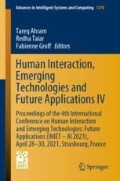Abstract
While the use of Augmented Reality (AR) for pilot support in military and commercial aviation is already established, the easier access to high-tech AR devices offers new possibilities to explore the usefulness of these technologies in General Aviation. Research shows that landing a light aircraft is one of the most difficult parts of the ab initio flight training. This is also an area considered to benefit from AR. For this exploratory study, an AR application was developed to support the landing approach on a flight simulator with a Flight Path Vector (FPV), altitude, air speed and a feedback-tool. Training effects are descriptively analyzed by comparing learners’ self-evaluation and landing performance. This study provides first insights into the design, implementation, and evaluation of an AR application to support ab initio flight training. In addition, empirical data of the usefulness and limitations of the tested AR application in a flight simulator setting are discussed.
Access this chapter
Tax calculation will be finalised at checkout
Purchases are for personal use only
References
Brown, L.: The next generation classroom: transforming aviation training with augmented reality. In: Proceedings of the National Training Aircraft Symposium (NTAS), Embry-Riddle Aeronautical University, Daytona Beach, FL, USA, 14–16 August 2017
Moesl, B., Schaffernak, H., Vorraber, W., Braunstingl, R., Herrele, T., Koglbauer, I.: A Research Agenda for Implementing Augmented Reality in Ab Initio Pilot Training (In review)
Lintern, G., Roscoe, S.N.: Transfer of landing skill after training with supplementary visual cues. In: Visual Simulation and Image Realism I, vol. 162, pp. 83–87. International Society for Optics and Photonics (1978)
Newman, R., Greeley, K., Schwartz, R., Ellis, D.: A Head-up display for general aviation. SAE Trans. 109, 197–206 (2000)
Newman, R.L.: Head-up Displays: Designing the Way Ahead. Routledge (2017)
Sutherland, I.: A head-mounted three dimensional display. In: Proceedings of the December 9–11, 1968, Fall Joint Computer Conference, Part I, pp. 757—764. Association for Computing Machinery, San Francisco (1968)
Mann, S.: Wearable computing: a first step toward personal imaging. Computer 30, 25–32 (1997)
Mann, S.: Wearable computing. In: Soegaard, M., Dam, R.F. (eds.) The Encyclopedia of Human-Computer Interaction, 2nd Ed., The Interaction Design Foundation, Denmark (2013)
Lee, K.: Augmented reality in education and training. TechTrends 56(2), 13–21 (2012)
Caudell, T., Mizell, D.: Augmented reality: an application of heads-up display technology to manual manufacturing processes. Proceedings of the Twenty-Fifth Hawaii International Conference on System Sciences 2, 659–669 (1992)
Delgado, F.J., Abernathy, M.F., White, J., Lowrey, W.H.: Real-time 3D flight guidance with terrain for the X-38. In: Enhanced and Synthetic Vision 1999, vol. 3691, pp. 149–156 (1999)
Halleran, M.S.: Gender balance in aviation. Coll. Aviat. Rev. Int. 37(1) (2019)
Mitchell, J., Kristovics, A., Vermeulen, L., Wilson, J., Martinussen, M.: How pink is the sky? A cross-national study of the gendered occupation of pilot. Employ. Relat. Rec. 5, 43–60 (2005)
Koglbauer, I.V.: Forschungsmethoden in der Verbindung Gender und Technik: Research Methods Linking Gender and Technology. Psychol. Österreich 37, 354–359 (2017)
Joiner, R., Iacovides, J., Owen, M., Gavin, C., Clibbery, S., Darling, J., Drew, B.: Digital Games, Gender and Learning in Engineering: Do Females Benefit as Much as Males? J. Sci. Educ. Technol. 20, 178–185 (2011)
Schaffernak, H., Moesl, B., Vorraber, W., Koglbauer, I.V.: Potential augmented reality application areas for pilot education: an exploratory study. Educ. Sci. 10, 86 (2020)
HoloLens (1st gen) hardware. https://docs.microsoft.com/en-us/hololens/hololens1-hardware
On the road for VR: Microsoft HoloLens at Build 2015. https://doc-ok.org/?p=1223
Frohmann, P.: Utilization of augmented reality in aviation - assisting small aircraft pilots in approaching and landing. MA thesis. Austria: Graz University of Technology (2019)
Coutant, B.E., Westheimer, G.: Population distribution of stereoscopic ability. Ophthalmic Physiol. Opt. 13, 3–7 (1993)
Acknowledgments
This research was funded by the Austrian Federal Ministry for Climate Action, Environment, Energy, Mobility, Innovation and Technology, and the Austrian Research Promotion Agency, FEMtech Program "Talent", grant number 866702.
Author information
Authors and Affiliations
Corresponding author
Editor information
Editors and Affiliations
Rights and permissions
Copyright information
© 2021 The Author(s), under exclusive license to Springer Nature Switzerland AG
About this paper
Cite this paper
Schaffernak, H., Moesl, B., Vorraber, W., Braunstingl, R., Herrele, T., Koglbauer, I. (2021). Design and Evaluation of an Augmented Reality Application for Landing Training. In: Ahram, T., Taiar, R., Groff, F. (eds) Human Interaction, Emerging Technologies and Future Applications IV. IHIET-AI 2021. Advances in Intelligent Systems and Computing, vol 1378. Springer, Cham. https://doi.org/10.1007/978-3-030-74009-2_14
Download citation
DOI: https://doi.org/10.1007/978-3-030-74009-2_14
Published:
Publisher Name: Springer, Cham
Print ISBN: 978-3-030-73270-7
Online ISBN: 978-3-030-74009-2
eBook Packages: Intelligent Technologies and RoboticsIntelligent Technologies and Robotics (R0)

